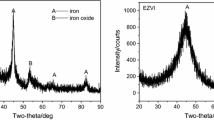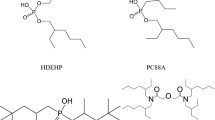Abstract
The hydrolysis of 4-Nitrophenylphosphate (NPP) in the presence of Ferrous and Ferric ions in Oil in water microemulsion media was investigated. The reaction was monitored by measuring the absorbance of the nitrophenolate ion produced in the reaction aliquots with time. The order of effectiveness of the microemulsion system towards the hydrolysis of NPP was found to be cationic > anionic> aqueous in the presence of Ferrous, Ferric and Turnbull’s blue at neutral pH. The result of the present investigation enriches our understanding of the possible roles polymetallic ions play in hydrolysis reactions. The reactions mimic the roles of purple acid phosphatases in the hydrolysis of phosphate esters. The application of the above systems for environmental decontamination of organophosphates is also envisoned.
Similar content being viewed by others
References
Baldwin, D. S., Beattie, J. K., Coleman, L. M., & Jones D. R. (1995). Phosphate ester hydrolysis mediated by mineral phases. Environmental Science and Technology, 29(6), 1706–1709.
Chin, J.(1991). Developing artificial hydrolytic metalloenzymes by a unified mechanistic approach. Accounts of Chemical Research, 24, 145–152.
Duboc-Toia, C., Menage, S., Vincent, J. M., Pouchot, A. M.,Therese, M., & Fontecave, M. (1997) Structure of a (μ-Oxo)dihydroxodiiron(III) complex and its reactivity toward phosphodiesters. Inorganic Chemistry, 36(27), 6148–6149.
Dugas, H., & Penney, C. (1989). Bioorganic chemistry, a chemical approach to enzyme action. Berlin Heidelberg New York: Springer.
Hubner, P. W. A., & Milburn, R. M. (1980). Hydrolysis of pyrophosphate to orthophosphate promoted by Cobalt(III). Evidence for the role of polynuclear species. Inorganic Chemicals, 19, 1267–1272.
Hung, H.-C., Huang, T.-M., & Chang, G.-G. (1997). Reverse micelles as a model system with which to study leaving group effects on alkaline phosphatase-catalysed hydrolysis. Journal of the Chemical Society. Perkin Transactions, 2(12), 2757–2760.
Kim, J., Harrison, R. G., Kim, C., & Que, L. Jr. (1996). Fe(TPA)-catalysed alkane hydroxylation. Metal-based oxidation vs radical chain autooxidation. Journal of the American Chemical Society, 118, 4373–4379.
Menger, F. M., & Erlington, A. R. (1991). Organic reactivity in microemulsion systems. Journal of the American Chemical Society, 113, 9621–9624.
Prince, L. M. (Ed.) (1977) Microemulsions. New York: Academic.
Rosso, D., Bartoletti, F., Di Profio, A., Germani, P., Savelli, R., Blasko, G., & Bunton, C. A. (1995). Hydrolysis of 2,4-dinitrophenyl phosphate in normal and reverse micelles. Journal of the Chemical Society, Perkin Transactions 2: Physical Organic Chemistry, (4), 673–678.
Savelli, G., Focher, B., & Bunton, C. A. (1990). Effects of head group structure on the properties of surfactants. Colloids and Surfaces, 48(1–3), 29–34.
Schomaecker, R., Schwuger, M. J., & Stickdorn, K. (1995). Microemulsions in technical processes. Chemical Reviews (Washington, DC.), 95(4), 849–864.
Tafesse, F. (1997). Hydrolysis of 4-nitrophenyl diphenyl phosphate (NPDPP) assisted by tetraaminecobalt(III) in microemulsion media. Analyst, 122, 293–295.
Tafesse, F. (1998). Hydrolysis of nerve agent simulants by synergestic effects of tetraaminecobalt(III) and microemulsions. Inorganica Chimica Acta, 269(2), 287–291.
Tafesse, F., Deppa, N. C., (2004). Polymetallic complexes in microemulsions for the hydrolysis of 4-nitrophenyl phosphate: A bio-mimetic model for decontamination of organophosphates in the environment. Ecotoxicology and Environmental Safety, 58(2), 260–266.
Tafesse, F., Massoud, S. S., & Milburn, R. M. (1985). Adenosine 5′ Triphosphate (ATP) hydrolysis promoted by the highly rreactive hydroxoaquo(3,3′,3″,-triaminopropylamine)Cobalt(III) ions. Patterns of reactivity and mechanistic considerations. Inorganic Chemistry, 24, 2591–2593.
Tafesse, F., Massoud, S. S., & Milburn, R. M. (1993). Amine ligand effects in hydroxoaquatetraaminecobalt(III) ion promoted hydrolysis of adenosinetriphosphate Inorganic Chemistry, 32, 1864–1865.
Vincent, J. B., & Averill, B. A. (1990). An enzyme with a double identity: purple acid phosphatase and tartarate-resistant acid phosphatase. FASEB Journal, 4(12), 3009–3014.
Yang, Y. C. (1999). Chemical detoxification of nerve agent VX. Accounts of Chemical Research, 32, 109–115.
Acknowledgements
We thank Professor Sylvia Paul (UNISA) and Professor Walter Fockie (UP) for the support and assistance they offered to us graciously. The financial support extended to Mr Mndubu by the chemistry department, UNISA, in the form of academic assistantship is gratefully acknowledged.
Author information
Authors and Affiliations
Corresponding author
Rights and permissions
About this article
Cite this article
Tafesse, F., Mndubu, Y. Iron Promoted Decontamination Studies of Nitrophenylphosphate in Aqueous and Microemulsion Media: A Model for Phosphate Ester Decontamination in the Environment. Water Air Soil Pollut 183, 107–113 (2007). https://doi.org/10.1007/s11270-007-9360-x
Received:
Accepted:
Published:
Issue Date:
DOI: https://doi.org/10.1007/s11270-007-9360-x




